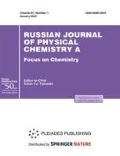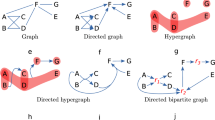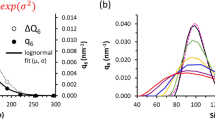Abstract
The field of continuous molecular shape and symmetry (dis)similarity quantifiers habitually called measures (specifically continuous shape measures (CShM) or continuous symmetry measures (CSM)) is obfuscated by the combinatorial numerical algorithms used in the field which restricts the applicability to the molecules containing up to twenty equivalent atoms. In the present paper we analyze this problem using various tools of classical probability theory as well as of one-particle and many-particle quantum mechanics. Applying these allows us to lift the combinatorial restriction and to identify the adequate renumbering of atoms (vertices) without considering all N! permutations of an N-vertex set so that in the end purely geometric molecular shape (dis)similarity quantifier can be defined. Developed methods can be easily implemented in the relevant computer code.



Similar content being viewed by others
Notes
They are not measures in the strict mathematical sense of this word, like area, volume or probability, rather more precisely can be dubbed as quantifiers.
Among N! permutations it is pretty easy to pick a wrong one since only one is correct.
Positiveness of κ is important as is of \(\mathcal{R}\) being a proper rotation, otherwise a chiral shape could be superimposed with its enantiomer.
Size doesn’t matter. Irrespective to it, cube remains a cube.
That of the functions integrable with their squares.
An inverse of the trick known yet to Kirchhoff and Helmholz who used a limit of Gaussians to represent an identity impulse – the δ-“function”: \(\delta (x)\) = \({{\lim }_{{\sigma \to 0}}}\frac{1}{{\sqrt {2\pi \sigma } }}\exp \left( { - \frac{{{{x}^{2}}}}{{2{{\sigma }^{2}}}}} \right)\) to be used only under integral over x.
Squared L2 (\({{\mathbb{R}}^{3}}\)) norms of \(\rho _{P}^{{(\sigma )}}\) and \(\rho _{T}^{{(\sigma )}}\) considered as its elements. It naturally applies only to distributions which are representable by the functions integrable with their squares.
The direct consequence of the triangle inequality.
(Pk − Tj)2 = (Pk − Tj')2; j ≠ j '.
The difference is the sum of interference terms (known in quantum chemistry as “differential overlaps”) \(\chi _{{\mathbf{Q}}}^{{(\sigma )}}({\mathbf{R}})\chi _{{{\mathbf{Q}}'}}^{{(\sigma )}}({\mathbf{R}})\)—the price of the consistent quantum description, which any way rapidly decays with increase of the separation between Q and Q' and decrease of dispersion.
Either of functions \({{\rho }_{Q}},\;\rho _{Q}^{{(\sigma )}},\;\psi _{P}^{{(\sigma )}}\) is that of one vector R as its argument which can eventually represent coordinates of only one particle, thus in the terminology of statistical physics and quantum mechanics those functions are one-particle densities or amplitudes.
Like electrons where respective functions are known as Slater determinants.
The outer or Grassmann product \({{ \wedge }^{N}}{{L}^{2}}({{\mathbb{R}}^{3}})\) of the L2(\({{\mathbb{R}}^{3}}\)) Hilbert spaces of functions of each variable Ri.
“As small as possible” is not actually that small. Taking the separation between the nearest vertices in the pattern set for unity we estimate \(\sigma = \frac{1}{{2\sqrt 2 }}\), which assures the factor \(\frac{1}{{{{e}^{2}}}}\)—almost one tenth—for the Carbó index of two normal distributions centered in these vertices. Then in order to assure that for the “close” distance the quadratic approximation for the Gaussian filter is valid, it is enough to set its argument \( < {\kern 1pt} \frac{1}{9}\) that is the distance between the “close” vertices must be less than \(\frac{1}{{3\sqrt 2 }}\) which assures the precision of the quadratic approximation at the level of 0.7%—more than enough for whatever practical applications.
REFERENCES
M. Pinsky and D. Avnir, Inorg. Chem. 37, 5575 (1998).
D. Casanova, J. Cirera, M. Llunell, P. Alemany, D. Avnir, and S. Alvarez, J. Am. Chem. Soc. 126, 1755 (2004).
H. Zabrodsky, S. Peleg, and D. Avnir, J. Am. Chem. Soc. 114, 7843 (1992);
H. Zabrodsky and D. Avnir, J. Am. Chem. Soc. 117, 462 (1995).
P. Alemany, D. Casanova, S. Alvarez, C. Dryzun, and D. Avnir, Rev. Comput. Chem. 30, 289 (2017).
C. Dryzun and D. Avnir, Phys. Chem. Chem. Phys. 11, 9653 (2009).
M. Pinsky, C. Dryzun, D. Casanova, P. Alemany, and D. Avnir, J. Comput. Chem. 29, 2712 (2008). https://doi.org/10.1002/jcc.20990
G. G. Malenkov, J. Struct. Chem. 57, 793 (2016);
A. L. Tchougreeff, AIP Conf. Proc. 1906, 030004 (2017). https://doi.org/10.1063/1.5012283; A. L. Tchougreeff, Theor. Chem. Acc. 137, 138 (2018). https://doi.org/10.1007/s00214-018-2322-0
A. I. Kostrikin and Yu. I. Manin, Linear Algebra and Geometry (Nauka, Moscow, 1986; CRC, Boca Raton, 1989).
L. Schwartz, Theorie des distributions (Hermann, Paris, 1951); A. Ya. Khelemskii, Lectures and Exercises on Functional Analysis (MTsNMO, Moscow, 2014; Am. Math. Soc., Philadelphia, 2006).
R. Carbo and B. Calabuig, Int. J. Quantum Chem., 42, 1695 (1992);
E. Besalu, R. Carbo, J. Mestres, and M. Solà, Top. Curr. Chem. 173, 31 (1995);
P. E. Bowen-Jenkins, D. L. Cooper, and W. G. Richards, J. Phys. Chem. 89, 2195 (1985);
R. Carbó and E. Besalú, Molecular Similarity and Reactivity: From Quantum Chemical to Phenomenological Approaches (Kluwer Academic, Amsterdam, 1995); R. Carbó and B. Calabuig, Int. J. Quantum Chem. 42, 1681 (1992);
R. Carbó, B. Calabuig, and E. Besalú, Adv. Quantum Chem. 25, 255 (1994);
R. Carbó, L. Leyda, and M. Arnau, Int. J. Quantum Chem. 17, 1185 (1980).
I. Mayer, Simple Theorems, Proofs, and Derivations in Quantum Chemistry (Kluwer Academic/Plenum, New York, 2003).
L. D. Landau and E. M. Lifshitz, Course of Theoretical Physics, Vol. 3: Quantum Mechanics: Non-Relativistic Theory (Nauka, Moscow, 1989; Pergamon, Oxford, 1977).
L. Zülicke, Quantenchemie, Ein Lehrgang, Band 1: Grundlagen und allgemeine Methoden (Deutscher Verlag der Wissenschaften, Berlin, 1973).
L. Piela, J. Kostrowicki, and H. A. Scheraga, J. Phys. Chem. 93 (8) (1989).
G. Fubini, Atti Reale Ist. Veneto Sci., Lett. Art. 63, 502 (1904);
E. Study, Math. Ann. 60, 321 (1905).
A. Kolmogorov, Grundbegriffe der Wahrscheinlichkeitsrechnung (Springer, Berlin, 1933); B. N. Tutubalin, The Theory of Probabilities and Stochastic Processes. Fundamentals of the Mathematical Apparatus and Applied Aspects (Mosk. Gos. Univ., Moscow, 1992) [in Russian].
D. C. Brody and L. P. Hughston, J. Geom. Phys. 38, 19 (2001);
P. Facchi, R. Kulkarni, V. I. Man’ko, G. Marmo, E. C. G. Sudarshan, and F. Ventriglia, Phys. Lett. A 374, 4801 (2010).
W. H. Press, S. A. Teukolsky, W. T. Vetterling, and B. P. Flannery, Numerical Recipes in C, 2nd ed. (Cambridge Univ. Press, Cambridge, 1992), Chap. 2.6.
F. R. Gantmacher, The Theory of Matrices (Chelsea, New York, 1960).
S. Gerschgorin, Bull. Acad. Sci. URSS, Math. Natur., No. 6, 749 (1931).
J. L. Littlewood, A Mathematician’s Miscellany (Methuen, London, 1953), p. 38.
ACKNOWLEDGMENTS
The author is thankful to Prof. Pere Alemany (Barcelona) who some years ago drew his attention to the problem of continuous shape and symmetry measures. Dr. Olga Chugreeva (Stuttgart) is acknowledged for valuable discussion.
Author information
Authors and Affiliations
Corresponding author
Additional information
Dedicated to my dear teacher Dr. Alexander I. Shtern on occasion of his 80th birthday
Rights and permissions
About this article
Cite this article
Tchougréeff, A.L. Quantum Metrics for Continuous Shape Measures of Molecules. Russ. J. Phys. Chem. 95, 1846–1856 (2021). https://doi.org/10.1134/S0036024421090272
Received:
Revised:
Accepted:
Published:
Issue Date:
DOI: https://doi.org/10.1134/S0036024421090272




